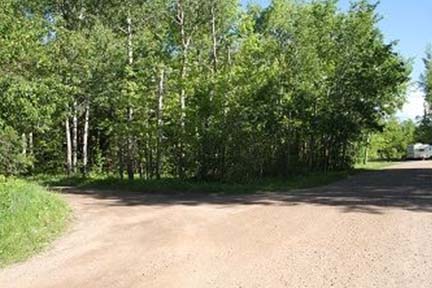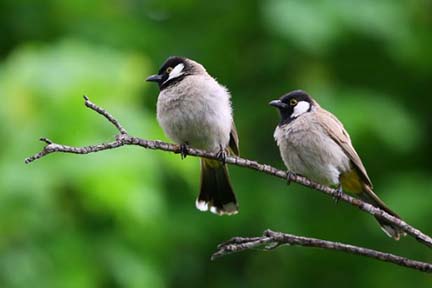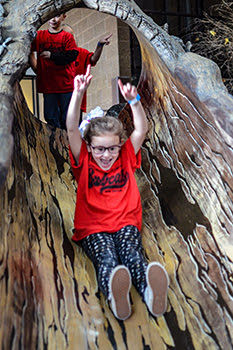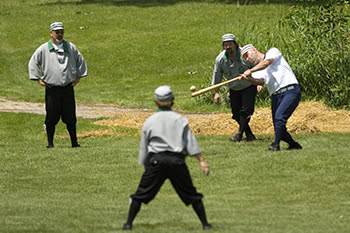Rangers to the rescue
By JOHN PEPIN
Michigan Department of Natural Resources
For many visitors to Porcupine Mountains Wilderness State Park, this fabled 60,000-acre countryside of virgin hardwoods and hemlocks, waterfalls and wilderness presents a formidable challenge.
The park, which stretches across portions of Gogebic and Ontonagon counties, is home to nearly 100 miles of hiking trails, the third-highest peak in Michigan, almost 20 miles of rocky and stark Lake Superior shoreline and the whitewater rapids of the Presque Isle River.
 For the park’s small band of experienced rangers – though skilled at search and rescue missions and first aid – the challenges posed by Michigan’s largest state park are even greater. For the park’s small band of experienced rangers – though skilled at search and rescue missions and first aid – the challenges posed by Michigan’s largest state park are even greater.
When a park visitor is lost or injured, time and distance become enemies as the park’s dimensions seem to grow exponentially in an instant – even for this most-skilled and well-trained rescue team in the western Upper Peninsula.
The rangers oversee this mountainous area serviced by only two main roads, where cellphone coverage is limited, especially within the park’s 35,000 acres of untrammeled wilderness.
“No two rescues are alike; no two are at the same scenic spot,” said Mike Knack, manager of the park and a member of the rescue team. “There’s no one profile of a lost or injured hiker. It spreads the whole spectrum of users.”
The statistical challenge
The number of incidents of lost and injured park visitors is split about equally in half.
In a typical year, park rangers respond to an average of 14 search and rescue incidents, two fatalities, five Lake Superior rescues and one to five calls for air support. |
 Because of the difficulty of the terrain, the distances involved and the usage restrictions in wilderness areas, an average search and rescue mission takes six to 10 hours to complete. Because of the difficulty of the terrain, the distances involved and the usage restrictions in wilderness areas, an average search and rescue mission takes six to 10 hours to complete.
A primary goal of emergency medical technicians is to get an injured person to medical care within 60 minutes – the so-called “golden hour.”
However, moving an injured visitor out of the park usually proceeds at about 1 mile per hour. It takes the fastest helicopter 45 minutes to arrive. The quickest an ambulance can get to the most accessible parts of the park is 20 minutes. The nearest regional medical centers are located 130 miles away in Marquette or 160 miles away in Wausau, Wisconsin.
State police canine units respond to searches from posts at either Calumet, about 85 miles away, or Gladstone, which is located more than double that distance away from Silver City – the park’s eastern gateway community.
“We have the potential of encountering something quite bad,” Knack said. “This is a unique state park in terms of the number of trails and rescues.”
Most of the fatalities involve heart attacks, heat exhaustion or heat stroke and drowning. |
 With loose rocks, tree roots and slippery mud on trails, the No. 1 injury at the park is broken legs – tibia or fibula fractures. Other common problems include heat stroke and dehydration. With loose rocks, tree roots and slippery mud on trails, the No. 1 injury at the park is broken legs – tibia or fibula fractures. Other common problems include heat stroke and dehydration.
Those who get lost at the park are often new visitors who lose their way looking for the park’s three big attractions – the Lake of the Clouds overlook, Summit Peak and the series of waterfalls along the Presque Isle River.
The park has no outstanding missing persons, homicide or other cold cases.
Park response
Most rescue and missing persons incidents are reported in the evening hours, after Porkies park rangers have already worked an eight- or 10-hour day.
Knack typically serves as incident commander for the operations, though other rangers out in the park on the search and rescue efforts might also assume lead roles. |
 The park has nine rangers trained in National Association of Search and Rescue techniques; two are trained and licensed EMTs. Seasonal and other park staffers are also often called to assist during park incidents. The park has nine rangers trained in National Association of Search and Rescue techniques; two are trained and licensed EMTs. Seasonal and other park staffers are also often called to assist during park incidents.
Gina Penegor is an accounting assistant at the park. She has worked there for the past five years. During this time, she has been among staffers who lend their support services during search and rescue events.
Penegor said she wants visitors planning to come to the park to anticipate its rugged character, which includes mud, bugs and places along the trail they are going to want to stop to enjoy the sights.
She said when calls are received about lost or injured park visitors, Michigan Department of Natural Resources park personnel gather as much information on the situation as they can.
“Being at park headquarters, we have the base radio and telephone service to prepare for the situation. I also answer multiple phone calls regarding backcountry camping/hiking and try to give the guests as much guidance as they will take,” Penegor said. “We do get a lot of calls from family members not being able to get in contact with family in the park. It’s hard for them to understand that we don’t have cell service in the park.”
Penegor has performed a range of duties during park emergencies, including covering radio traffic as part of the incident command team, keeping track of the incident timeline by documenting radio transmissions, contacting emergency service providers, covering for park staff involved in the response and updating affected family members on progress of the situation as it unfolds.
First-aid aid
Responding to these incidents consumes a good chunk of the park’s budget. |
 “We probably have more spent on first-aid supplies than other ranger districts as a whole,” Knack said. “We probably have more spent on first-aid supplies than other ranger districts as a whole,” Knack said.
Over the years, park staff has made improvements to search and rescue equipment, including purchases made with funds contributed by the Friends of the Porkies group.
In 2016, the Friends of the Porkies asked park staff for a needs list. Their No. 1 need was for rescue equipment: a rescue tent with a heater, a wheel-a-body and an all-terrain vehicle. The Friends kicked off its fundraising drive in January 2017 and titled it “Rescue Me.”
“We needed to raise almost $40,000 to totally fund the purchase of the equipment. Through fundraisers and the generosity of donors, by spring 2018 we had raised the necessary funds,” said Sally Berman, board president of the Friends of the Porkies. “We purchased all of the equipment and had it delivered to park headquarters by early June. Park staff featured the Argo (ATV) in the White Pine July 4th parade and the Ontonagon Labor Day parade.”
The popularity challenges
Over an average year, Porcupine Mountains Wilderness State Park attracts between 400,000 and 450,000 visitors.
However, that changed dramatically with the coronavirus pandemic.
Across the state, the DNR saw an unexpected increase in the number of people heading to the outdoors for recreation, many experiencing activities like fishing, hunting and hiking for the first time. |
 The sales of hunting and fishing licenses increased in kind. In 2020, Michigan state parks and recreation areas saw a 30% increase in visits, with over 35 million visitors statewide. The sales of hunting and fishing licenses increased in kind. In 2020, Michigan state parks and recreation areas saw a 30% increase in visits, with over 35 million visitors statewide.
At the Porcupine Mountains, cabin and campsite reservations sold out. Wait times of nearly an hour were reported to visit the Lake of the Clouds scenic overlook.
Park visitation soared to a record 600,000, even with the park being closed from April through June because of coronavirus restrictions, bringing an influx of visitors new to outdoor recreation.
“We saw cars packed with new camping gear, hikers pulling new boots out of the box to hit the trails,” Knack said. “We saw first-time campers with tons of inexperience.”
Tenderfoot hikers and campers were not ready for the challenges of the rugged 2,000-foot-high mountains that cause the lungs and legs of even experienced park visitors and DNR staffers to burn.
Visitation was split about evenly between experienced and neophyte park patrons.
Prior to 2020, the highest number of park search and rescue or injury incidents peaked at 30 in 2016, when some major storm events affected conditions at the park.
Last year, the park rangers responded to 52 search and rescue or injury incidents, despite only a single incident being logged from January through June.
Park managers expect camping and lodging reservations to again sell out in the Porcupine Mountains this year. Visitors looking for a nearby state park to stay at should consider Lake Gogebic State Park, which is typically less crowded.
So far this year, with an early winter thaw, which increased numbers of early-season visitors, rescues at the park from January to present have already reached 20, including one fatality.
Meeting the challenge
To meet the challenge of the increased number of park visitors, many of whom are inexperienced, staff at the Porcupine Mountains is taking several steps to try to improve the situation. |
 One primary effort focuses on educating park visitors. One primary effort focuses on educating park visitors.
Rangers recommend visitors stop at the park visitor center before heading out into the park. In addition to providing park maps and other information, knowledgeable staffers there can answer a wide range of questions.
“We are also looking to be more instructive on the nuts and bolts of backpacking 101,” Knack said.
Some of these backpacking basics to be presented at the park visitor center will include reminding hikers to leave no trace of their presence by packing out whatever they pack in and preparation tips, including the “10 essentials” hikers should be sure to pack in their knapsacks or backpacks.
These essentials include:
- A map and compass for navigation.
- Sunglasses and sunscreen for solar protection.
- Extra clothing for insulation.
- A headlamp or flashlight for illumination.
- First-aid supplies.
- Waterproof matches, a lighter or candles to help start a campfire.
- A repair kit and tools.
- Extra food for nutrition.
- Extra water for hydration.
- An emergency shelter.
New trail signs, like those hikers may be familiar with from the North Country National Scenic Trail, are being put up at the park under a new pilot program aimed at providing better direction and location information for those using the trails.
In cases where hikers become lost, these confidence markers should be helpful to searchers and the missing. Trail descriptions are being updated on the DNR website to include challenges visitors might face and more details on character of the trails.
Park visitors are encouraged to learn about the park and the basics of hiking and backpacking – like breaking in hiking boots before wearing them on a lengthy walk –before arriving at the Porcupine Mountains.
Following the Boy Scouts’ motto to “be prepared” is perhaps the best advice for park visitors.
These picturesque mountains, modest by western standards, offer many places where hemlock cathedrals provide inspiring places for peace and reflection.
In addition, the Porcupine Mountains is a place of forest lakes surrounded with evidence of an active geologic past, including an escarpment that separates a high, rocky plateau from the Big Carp River and the Lake of the Clouds below.
Other evocative place names lending credence to the rugged and deep forest mountain character of this area, known well to the American Indians of the region, include Miscowawbic Peak, Manabezho Falls, Mirror Lake, Lost Creek Outpost and Green Mountain Peak.
The character of this land provides a world of wonder and enchantment to park visitors, but also challenges they should be ready for.
Meanwhile, the park’s rangers and other staffers continue to train for the next call for help. They don’t know when it will come, but they know that it will.
When it does, they will respond to wherever it is within the nearly 100 square miles of this spectacular setting. They will be ready. |
Check out previous Showcasing the DNR stories in our archive at Michigan.gov/DNRStories. To subscribe to upcoming Showcasing articles, sign up for free email delivery at Michigan.gov/DNR.
/Note to editors: Contact: John Pepin, Showcasing the DNR series editor, 906-226-1352. Accompanying photos and a text-only version of this story are available below for download. Caption information follows. Credit Michigan Department of Natural Resources, unless otherwise noted.
Text-only version of this story.
Argo: Porcupine Mountains Wilderness State Park was able to purchase this all-terrain vehicle and other needed rescue equipment thanks to fundraising efforts of the Friends of the Porkies group.
Basket: The experienced rangers at Porcupine Mountains Wilderness State Park are well trained in search and rescue skills. Pictured here, a Coast Guard basket lift training.
Litter: Ranger Steve Negovan pulls a rescue litter, a stretcher designed to transport injured people out of hard-to-reach areas and over rugged terrain.
Overlook: Visitors enjoy a sunny day at the Lake of the Clouds overlook, the signature attraction at Porcupine Mountains Wilderness State Park in Ontonagon County.
Ropes 1, Ropes 2, Ropes 3: Porcupine Mountains Wilderness State Park rangers are trained in a variety of search and rescue techniques, including using rescue ropes. Pictured here, Ranger Steve Negovan (Ropes 1), Lead Ranger Michael Grzenia (Ropes 2) and Ranger Aaron Schneider (Ropes 3) participate in rope training.
Sign: A sign at Porcupine Mountains Wilderness State Park warns of the dangers along the water course at the Presque Isle River on the western end of the 60,000-acre park.
Training: Porcupine Mountains Wilderness State Park’s small band of experienced rangers are trained to be skilled at search and rescue missions and first aid to face the challenges posed by Michigan’s largest state park.
Waterfalls: Park visitors take in the series of waterfalls along the Presque Isle River at Porcupine Mountains Wilderness State Park./ |



 Lake frontage, trail access, small lots to extend a neighborhood lot – these types of acreage and more are available in the next round of surplus land auctions from the Michigan Department of Natural Resources. After careful consideration of properties it manages on behalf of Michigan residents, the DNR has selected 97 that are much better suited for private ownership and is preparing those for sale via online auctions in August and early September.
Lake frontage, trail access, small lots to extend a neighborhood lot – these types of acreage and more are available in the next round of surplus land auctions from the Michigan Department of Natural Resources. After careful consideration of properties it manages on behalf of Michigan residents, the DNR has selected 97 that are much better suited for private ownership and is preparing those for sale via online auctions in August and early September.

 Want to see more pictures like this, taken by Michigan state parks photo ambassador
Want to see more pictures like this, taken by Michigan state parks photo ambassador  A striking fish with a sail-like dorsal fin and slate-blue coloration, the Arctic grayling was virtually the only native stream salmonid (a fish of the salmon family) in the northern Lower Peninsula until the population died off nearly a century ago. Three factors contributed to the grayling’s demise in Michigan: habitat destruction, unregulated harvest and predation/competition from nonnative fish species.
A striking fish with a sail-like dorsal fin and slate-blue coloration, the Arctic grayling was virtually the only native stream salmonid (a fish of the salmon family) in the northern Lower Peninsula until the population died off nearly a century ago. Three factors contributed to the grayling’s demise in Michigan: habitat destruction, unregulated harvest and predation/competition from nonnative fish species.
 Record numbers of people are heading to Michigan’s outdoors this summer, exploring forests to enjoy the beauty of wildflowers, bright songbirds and splashing waterways. This captivating scenery is, unfortunately, sometimes marred by something less beautiful: dumpsites.
Record numbers of people are heading to Michigan’s outdoors this summer, exploring forests to enjoy the beauty of wildflowers, bright songbirds and splashing waterways. This captivating scenery is, unfortunately, sometimes marred by something less beautiful: dumpsites.
 The Report All Poaching hotline is hiring three emergency dispatchers to join the Michigan DNR Law Enforcement team. The right candidates are motivated team players with excellent communication skills who want to help solve natural resources crimes and provide safe community environments.
The Report All Poaching hotline is hiring three emergency dispatchers to join the Michigan DNR Law Enforcement team. The right candidates are motivated team players with excellent communication skills who want to help solve natural resources crimes and provide safe community environments.

 July 7, 2021
July 7, 2021
 For the park’s small band of experienced rangers – though skilled at search and rescue missions and first aid – the challenges posed by Michigan’s largest state park are even greater.
For the park’s small band of experienced rangers – though skilled at search and rescue missions and first aid – the challenges posed by Michigan’s largest state park are even greater.
 Because of the difficulty of the terrain, the distances involved and the usage restrictions in wilderness areas, an average search and rescue mission takes six to 10 hours to complete.
Because of the difficulty of the terrain, the distances involved and the usage restrictions in wilderness areas, an average search and rescue mission takes six to 10 hours to complete.
 With loose rocks, tree roots and slippery mud on trails, the No. 1 injury at the park is broken legs – tibia or fibula fractures. Other common problems include heat stroke and dehydration.
With loose rocks, tree roots and slippery mud on trails, the No. 1 injury at the park is broken legs – tibia or fibula fractures. Other common problems include heat stroke and dehydration.
 The park has nine rangers trained in National Association of Search and Rescue techniques; two are trained and licensed EMTs. Seasonal and other park staffers are also often called to assist during park incidents.
The park has nine rangers trained in National Association of Search and Rescue techniques; two are trained and licensed EMTs. Seasonal and other park staffers are also often called to assist during park incidents.
 “We probably have more spent on first-aid supplies than other ranger districts as a whole,” Knack said.
“We probably have more spent on first-aid supplies than other ranger districts as a whole,” Knack said.
 The sales of hunting and fishing licenses increased in kind. In 2020, Michigan state parks and recreation areas saw a 30% increase in visits, with over 35 million visitors statewide.
The sales of hunting and fishing licenses increased in kind. In 2020, Michigan state parks and recreation areas saw a 30% increase in visits, with over 35 million visitors statewide.
 One primary effort focuses on educating park visitors.
One primary effort focuses on educating park visitors.


 Want to see more pictures like this, taken by Michigan state parks photo ambassador
Want to see more pictures like this, taken by Michigan state parks photo ambassador  Summer sunshine is here, and with it comes long lakeside days, evenings by the campfire and the excitement of Independence Day celebrations. That sunshine, though, brings drought conditions that have affected portions of Michigan, leaving forests and fields vulnerable to wildfire. Even with recent rain, fire risks remain, especially in northern Michigan. DNR firefighters have already responded to 240 or more blazes this year.
Summer sunshine is here, and with it comes long lakeside days, evenings by the campfire and the excitement of Independence Day celebrations. That sunshine, though, brings drought conditions that have affected portions of Michigan, leaving forests and fields vulnerable to wildfire. Even with recent rain, fire risks remain, especially in northern Michigan. DNR firefighters have already responded to 240 or more blazes this year.
 The smoky-sweet smell of bratwursts on the grill can entice more than just your Uncle Bob. Food scraps and odors left on unclean grills are enough to attract bears and other curious wildlife. As we head into the holiday weekend, keep in mind that properly cleaning grills, eating utensils and picnic areas helps protect bears and keep wildlife wild.
The smoky-sweet smell of bratwursts on the grill can entice more than just your Uncle Bob. Food scraps and odors left on unclean grills are enough to attract bears and other curious wildlife. As we head into the holiday weekend, keep in mind that properly cleaning grills, eating utensils and picnic areas helps protect bears and keep wildlife wild.
 You have about two more weeks to enter the Explore MI Wetland Wonders Challenge by visiting one of
You have about two more weeks to enter the Explore MI Wetland Wonders Challenge by visiting one of 
 Registration is open for the 2021 Barbara J. Brown Family History Seminar, which will be held virtually via Zoom July 9-10.
Registration is open for the 2021 Barbara J. Brown Family History Seminar, which will be held virtually via Zoom July 9-10.
 The DNR Outdoor Adventure Center in Detroit is thrilled to announce its reopening July 16!
The DNR Outdoor Adventure Center in Detroit is thrilled to announce its reopening July 16!
 Learn more about Michigan’s stories with the Michigan History Center’s online and in-person events in July.
Learn more about Michigan’s stories with the Michigan History Center’s online and in-person events in July.
 Several state parks will host introductory classes to help newcomers get started with turkey hunting, pheasant hunting and archery.
Several state parks will host introductory classes to help newcomers get started with turkey hunting, pheasant hunting and archery.